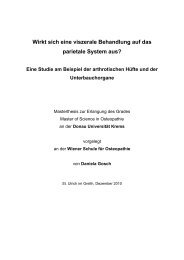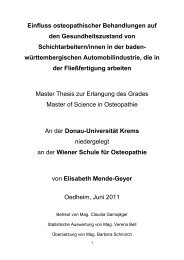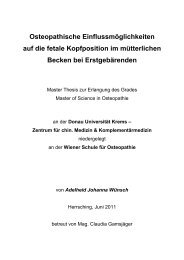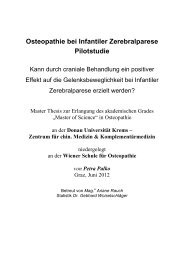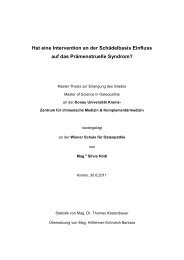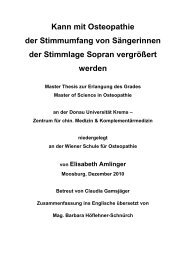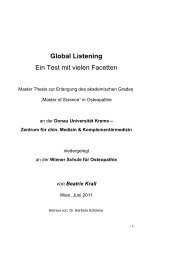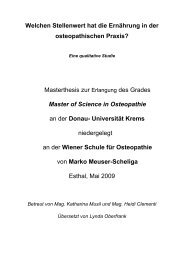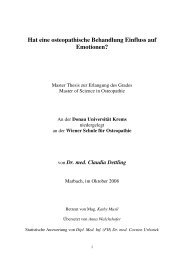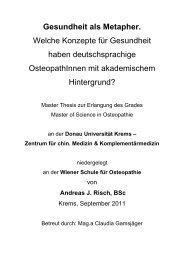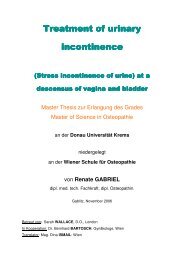Comparison between CV4 and EV4 - Osteopathic Research
Comparison between CV4 and EV4 - Osteopathic Research
Comparison between CV4 and EV4 - Osteopathic Research
You also want an ePaper? Increase the reach of your titles
YUMPU automatically turns print PDFs into web optimized ePapers that Google loves.
21<br />
2.4.2.1 Cardiovasculatory centre:<br />
In the reticular formation, afferent impulses travel from presso <strong>and</strong> chemoreceptors<br />
in the carotid sinus <strong>and</strong> the aortic arch via the vagus nerve <strong>and</strong> the<br />
glossopharyngeal nerve to the solitary tract nuclei, where they are then further<br />
transmitted <strong>and</strong> processed. This network of neural transmission <strong>and</strong> switching<br />
controls the efferent activity of pre-ganglionary sympathetic <strong>and</strong><br />
parasympathetic neurones; thus ensures the short-term regulation of blood<br />
pressure <strong>and</strong> its adaptation to various conditions.<br />
A resting pulse normally lies <strong>between</strong> 60 <strong>and</strong> 80 beats per minute, depending on<br />
one’s fitness level.<br />
Efferent impulses travelling through the vagus nerve diverge as rami cardiaci on<br />
both sides, <strong>and</strong> go to the right side of the heart <strong>and</strong> to the sinoatrial nodes. Their<br />
restricting effect on the sympathetic fibres causes a decrease in pulse.<br />
Other impulses cause a functional restriction of the sympathetic fibres<br />
controlling the width of blood vessels that leads to vasodilatation.<br />
2.4.2.2 Respiratory centre<br />
Because of its vital importance, respiratory rhythm can only be consciously<br />
influenced in the short term. Respiration rhythm at rest usually lies around 10-<br />
14/cpm for adults <strong>and</strong> 14-16/cpm for youths. 20 Chemical breath regulation<br />
ensures the body’s equilibrium <strong>and</strong> that respiration is adapted to its metabolic<br />
needs.<br />
The respiratory centre controls itself to a large extent. Changes in arterial blood<br />
gases (partial compression of CO2 <strong>and</strong> O2) <strong>and</strong> pH play the biggest role in<br />
respiratory regulation. 21 The tension level of the pulmonary alveoli provides<br />
feedback to the respiratory centre via the vagus nerve. Chemo-receptors in the<br />
20 SCHMIDT Robert: Physiologie kompakt, 4. Auflage, Berlin, Heidelberg, New York: Springer Verlag,<br />
2001, p 227<br />
21 FALLER Adolf: Der Körper des Menschen, 13. Auflage (neu bearbeitet von M. und G. Schünke),<br />
Stuttgart, New York: Thieme Verlag, 1999, p.363<br />
Margit Grill / 2006



